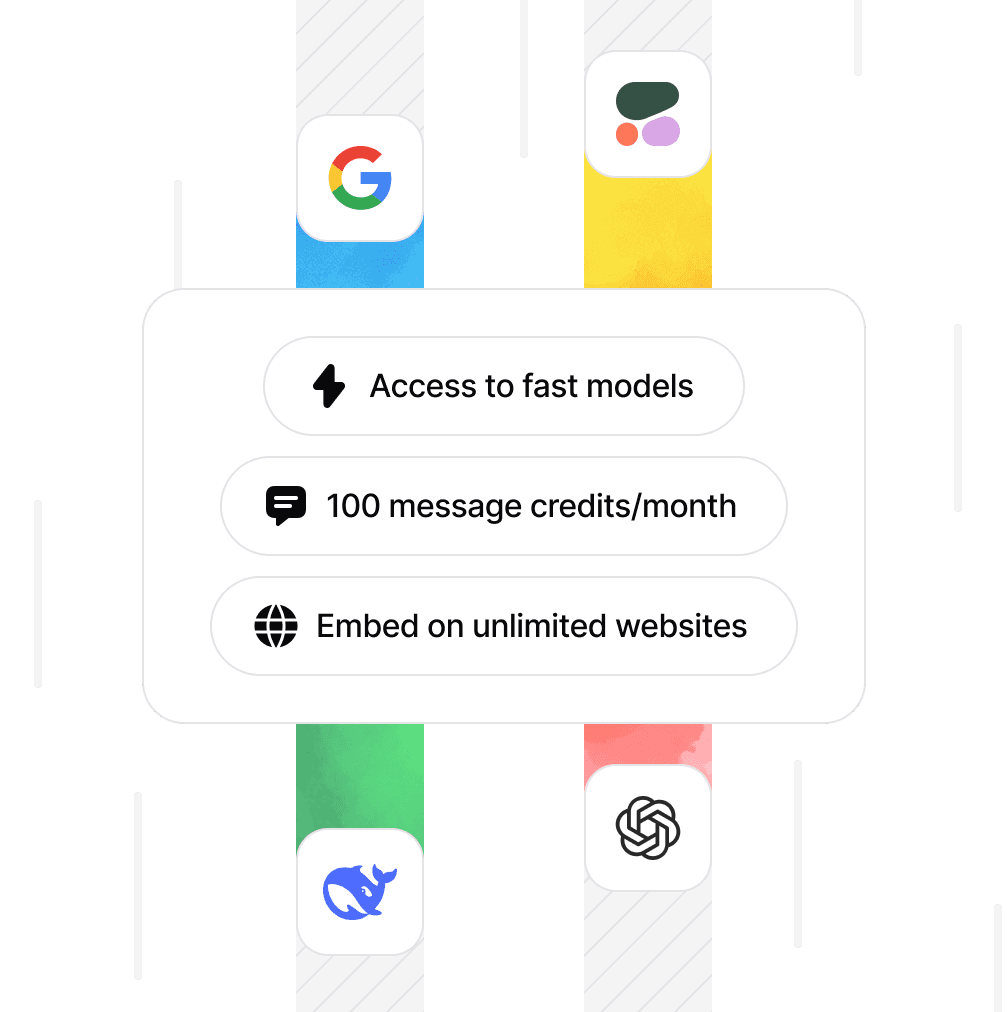The Complete Guide to Using Chatbots for Sales
Ilias Ism
May 15, 2024
10 min read

In today's fast-paced, digital-first sales-heavy business landscape, companies are constantly seeking innovative ways to engage customers, generate leads, and drive sales.
One technology that has emerged as a game-changer in recent years is the sales chatbot.
Powered by artificial intelligence (AI) and machine learning, these intelligent virtual assistants are transforming the way businesses interact with prospects and customers across the sales funnel.
What is a Sales Chatbot?
A sales chatbot is an AI-powered software application designed to simulate human-like conversations with potential and existing customers.
These chatbots leverage natural language processing (NLP) and machine learning algorithms to understand user queries, provide relevant information, and guide users through the sales process.
Sales chatbots can be integrated into various platforms, including websites, messaging apps, and social media, enabling businesses to engage with customers 24/7 across multiple channels.
Key Benefits of Sales Chatbots
1. 24/7 Availability and Instant Responses
![[object Object]](/_next/image?url=https%3A%2F%2Fcdn.sanity.io%2Fimages%2Fi6kpkyc7%2Fprod-dataset%2F2db989f1504350d4a1f921a1f96c3f017925cbf8-1520x800.jpg&w=3840&q=75)
One of the most significant advantages of sales chatbots is their round-the-clock availability.
Unlike human sales representatives, chatbots never sleep, take breaks, or go on vacation.
They can engage with customers anytime, anywhere, providing instant responses to their queries and concerns.
This 24/7 availability not only improves customer satisfaction but also ensures that businesses never miss an opportunity to generate leads or close a sale.
2. Lead Generation and Qualification
![[object Object]](/_next/image?url=https%3A%2F%2Fcdn.sanity.io%2Fimages%2Fi6kpkyc7%2Fprod-dataset%2Fdbacbe6e3b5ff3925adda1c09b48836959f23a52-1520x800.jpg&w=3840&q=75)
Sales chatbots can be a powerful tool for lead generation and qualification.
By engaging website visitors proactively, chatbots can capture user information, understand their needs and preferences, and guide them through the sales funnel.
Chatbots can ask qualifying questions, provide personalized recommendations, and even schedule demos or appointments with sales representatives.
By automating the lead generation and qualification process, chatbots can help businesses save time and resources while improving the quality of leads passed on to the sales team.
3. Personalized Customer Engagement
![[object Object]](/_next/image?url=https%3A%2F%2Fcdn.sanity.io%2Fimages%2Fi6kpkyc7%2Fprod-dataset%2Fffedcfc103e02f05eee4087244f0d9d9165a6828-1520x800.jpg&w=3840&q=75)
AI-powered sales chatbots can deliver highly personalized experiences to customers by leveraging data from various sources, such as customer profiles, browsing history, and past interactions.
By understanding individual customer preferences and needs, chatbots can provide tailored recommendations, offer relevant content, and adapt their communication style to suit each user.
This level of personalization enhances customer engagement and builds trust and loyalty, leading to higher conversion rates and customer lifetime value.
4. Streamlined Sales Process
![[object Object]](/_next/image?url=https%3A%2F%2Fcdn.sanity.io%2Fimages%2Fi6kpkyc7%2Fprod-dataset%2F854819b5af3969fd1295a228abeac22d4fa8bd54-1520x800.jpg&w=3840&q=75)
Sales chatbots can streamline and automate various aspects of the sales process, from initial contact to post-sale support.
By handling routine tasks such as answering frequently asked questions, providing product information, and processing transactions, chatbots can free up sales representatives to focus on more complex and high-value activities.
Chatbots can also integrate with CRM systems and other sales tools, ensuring seamless data flow and enabling sales teams to access real-time insights for better decision-making.
5. Cost-Effective and Scalable
![[object Object]](/_next/image?url=https%3A%2F%2Fcdn.sanity.io%2Fimages%2Fi6kpkyc7%2Fprod-dataset%2Fcc4c015ddab403edeae0a669e0bd29eaf703dce0-1520x800.jpg&w=3840&q=75)
Implementing sales chatbots can be a cost-effective solution for businesses looking to scale their sales and customer support operations.
Unlike hiring additional sales representatives, chatbots require a one-time development cost and minimal ongoing maintenance.
As chatbots can handle multiple conversations simultaneously, they can effectively scale to meet growing customer demands without the need for additional resources.
This scalability enables businesses to expand their reach, enter new markets, and handle spikes in customer inquiries without compromising on the quality of service.
Best Practices for Implementing Sales Chatbots
While sales chatbots offer numerous benefits, implementing them effectively requires careful planning and execution.
Here are some best practices to consider:
1. Define Clear Goals and Use Cases
Before implementing a sales chatbot, it's crucial to define clear goals and use cases.
What do you want to achieve with your chatbot? Is it lead generation, customer support, or sales automation?
By identifying specific objectives and mapping out the customer journey, you can design a chatbot that aligns with your business goals and delivers tangible results.
2. Choose the Right Platform and Technology
Selecting the right chatbot platform and technology is essential for success.
Consider factors such as ease of use, customization options, integration capabilities, and scalability when evaluating different solutions.
Look for platforms that offer pre-built templates, drag-and-drop interfaces, and robust analytics to simplify chatbot development and optimization.
3. Design Engaging and Conversational Interactions
To create a positive user experience, design your sales chatbot to engage in natural, conversational interactions.
Use a friendly and approachable tone, incorporate humor and personality, and provide clear and concise responses.
Ensure that your chatbot can handle a wide range of user queries and gracefully escalate complex issues to human agents when necessary.
4. Integrate with Existing Systems and Processes
To maximize the value of your sales chatbot, integrate it with your existing systems and processes, such as CRM, marketing automation, and customer support tools.
This integration enables seamless data flow, personalized interactions, and a holistic view of the customer journey.
By leveraging data from multiple sources, your chatbot can provide more accurate and relevant responses, leading to better customer experiences and higher conversion rates.
5. Continuously Monitor, Analyze, and Optimize
Implementing a sales chatbot is not a one-time event but an ongoing process of continuous improvement.
Regularly monitor your chatbot's performance, analyze user interactions, and gather feedback to identify areas for optimization.
Use chatbot analytics to track key metrics such as engagement rates, conversion rates, and customer satisfaction scores.
Based on these insights, refine your chatbot's responses, update its knowledge base, and experiment with new features and functionalities to drive better results.
Real-World Examples of Successful Sales Chatbots
Many companies across various industries have successfully implemented sales chatbots to drive customer engagement and boost sales. Here are a few notable examples:
Sephora: The beauty retailer's chatbot, powered by Kik, helps customers discover new products, get personalized recommendations, and even try on makeup virtually using augmented reality technology.
Domino's Pizza: The pizza chain's chatbot, named Dom, allows customers to order pizza, track their delivery status, and earn rewards points through a conversational interface on Facebook Messenger.
Marriott International: The hospitality giant's chatbot, powered by Amadeus, helps travelers book rooms, get property information, and receive personalized recommendations based on their preferences and past stays.
H&M: The fashion retailer's chatbot, powered by Kik, acts as a personal stylist, helping customers discover new outfits, get fashion advice, and make purchases directly through the chat interface.
These examples demonstrate how sales chatbots can be tailored to different industries and use cases, delivering value to both businesses and customers.
The Future of Sales Chatbots
As AI and machine learning technologies continue to advance, the future of sales chatbots looks promising.
We can expect chatbots to become even more sophisticated, with improved natural language understanding, sentiment analysis, and contextual awareness. Another exciting development is the rise of voice-based chatbots, or conversational AI assistants, such as Amazon's Alexa and Google Assistant.
As more consumers adopt voice-enabled devices, businesses will need to optimize their chatbots for voice interactions, creating new opportunities for sales and customer engagement.
Furthermore, the integration of chatbots with other emerging technologies, such as blockchain and augmented reality, will open up new possibilities for secure transactions, immersive product experiences, and seamless omnichannel journeys.
Conclusion
Sales chatbots are no longer a futuristic concept but a present-day reality that is transforming the way businesses engage with customers and drive sales.
By leveraging the power of AI and machine learning, sales chatbots offer 24/7 availability, personalized engagement, lead generation and qualification, and streamlined sales processes.
As the technology continues to evolve, we can expect sales chatbots to become even more sophisticated and integral to business success.
To stay ahead of the curve, companies must embrace sales chatbots as a strategic tool for customer engagement and sales growth.
By following best practices, integrating with existing systems, and continuously optimizing based on data-driven insights, businesses can harness the full potential of sales chatbots to drive revenue, improve customer satisfaction, and gain a competitive edge in the digital age.
Share this article:







